Enhancing Engineering Education in Transport Phenomena Through Project-Based Learning with a Nature-Based Solution Approach
Abstract
1. Introduction
2. Literature Review
3. Methodology
3.1. Implementation of PBL in the Transport Phenomena Course
- Project Introduction and Structure: Students were introduced to the concept of floating islands, their environmental significance, and the engineering principles involved in their design and implementation.
- Group Formation and Collaborative Work: Students worked in interdisciplinary teams, fostering collaboration between Environmental and Civil Engineering students.
- Experimental Setup and Data Collection: Students engaged in hands-on experiments involving plant quantity selection, system layout design, laboratory equipment operation, and data processing using specialized software.
- Evaluation Criteria: Student performance was assessed based on the quality of reports, accuracy in data analysis, teamwork, and project execution. Project scores were collected via a 10-point rubric, validated by peer review, assessing criteria such as report length (2500–5000 words), topic structure, measured velocity graphs, mass removal calculations, all measurements presented, experimental uncertainty propagation, 1 photo of the island, no plagiarism, and ABNT-compliant references. ABNT (Associação Brasileira de Normas Técnicas) specifies citation style (e.g., NBR 6023:2018) for Brazilian academic work. Each of the nine criteria was evaluated on a scale of 0 to 10, and the final project score was calculated as the average of these individual scores, validating results through consistent application across all 34 submissions (Table 1). The evaluation was conducted over two weeks with no penalties for delays but extensions with justification. Feedback was gathered from both instructors and students to evaluate the efficacy of PBL in enhancing learning outcomes.
3.2. Academic Standing and PBL Performance Analysis
3.3. Course of Transport Phenomena
3.4. Our PBL: Flow Distribution in FTIs Spanning the Channel Width
- How would you assess the importance of this project in relation to the subject studied?
- What challenges did you encounter while developing the project?
- What improvements can be made to enhance the understanding of the topic and the execution of the project?
- After completing the study, how do you evaluate floating islands as an engineering object?
- How would you rate your overall experience with the project (5 being excellent and 1 being a completely negative experience)?
4. Results and Discussion
4.1. Exploring Divergent Thinking in Enhancing FTIs for Pollutant Removal
4.2. Impact of Academic Standing on PBL Outcomes
4.3. Feedback from Instructors on Implementing PBL in the Transport Phenomena Course
4.4. Feedback from Students on Implementing PBL in the Transport Phenomena Course
- Ensure Comprehensive Information Transmission: Addressing concerns from 40% of respondents, it is crucial to effectively communicate all project-related information throughout the course. This may involve reviewing and restructuring content delivery to ensure clarity and relevance to project objectives, as highlighted by the majority (80%) valuing clear project communication.
- Incorporate Floating Islands Concept Throughout the Course: Another 40% of participants recommended integrating floating islands consistently across various course modules. This continuous exposure can establish a strong theoretical foundation early on, enabling students to connect classroom learning with practical applications later in the project. Consistent reinforcement of these concepts is essential for enhancing retention and application of knowledge, as affirmed by the 60% who found the project’s educational value exemplary.
- Integrate Relevant Questions into Exercise Lists: Although not specifically mentioned, incorporating exercises linking theoretical concepts to practical applications of floating islands could solidify understanding. Designing exercises requiring application of learned concepts to scenarios involving floating island technologies can deepen comprehension and engagement.
- Provide Practical Demonstrations: Approximately 20% of respondents expressed interest in practical demonstrations of floating island applications in a laboratory canal setting. Integrating such demonstrations can provide valuable hands-on experience, allowing students to observe firsthand the principles discussed in class and reinforcing theoretical knowledge with practical application. This approach aligns with recommendations for more interactive learning opportunities.
5. Conclusions
Author Contributions
Funding
Institutional Review Board Statement
Informed Consent Statement
Data Availability Statement
Conflicts of Interest
References
- ABET. (2022). Criteria for accrediting engineering programs, 2022–2023. Available online: https://www.abet.org/wp-content/uploads/2022/01/2022-23-EAC-Criteria.pdf (accessed on 1 February 2025).
- Akcali, E., Giang, W. C., & Landrum, M. (2020, June 22–26). Incorporating divergent thinking skills development into a project-based course in industrial and systems engineering. 2020 ASEE Virtual Annual Conference Content Access, Virtual Online. [Google Scholar]
- Almulla, M. A. (2020). The effectiveness of the project-based learning (PBL) approach as a way to engage students in learning. Sage Open, 10(3), 2158244020938702. [Google Scholar] [CrossRef]
- Baldock, T. E., & Chanson, H. (2006). Undergraduate teaching of ideal and real fluid flows: The value of real-world experimental projects. European Journal of Engineering Education, 31(6), 729–739. [Google Scholar] [CrossRef]
- Blumenfeld, P. C., Soloway, E., Marx, R. W., Krajcik, J. S., Guzdial, M., & Palincsar, A. (1991). Motivating project-based learning: Sustaining the doing, supporting the learning. Educational Psychologist, 26(3–4), 369–398. [Google Scholar] [CrossRef]
- Brundiers, K., & Wiek, A. (2013). Do we teach what we preach? An international comparison of problem- and project-based learning courses in sustainability. Sustainability, 5(4), 1725–1746. [Google Scholar] [CrossRef]
- Chiu, C. F. (2020). Facilitating K-12 teachers in creating apps by visual programming and project-based learning. International Journal of Emerging Technologies in Learning, 15(1), 103–118. [Google Scholar] [CrossRef]
- Cole, J. S., & Spence, S. W. (2012). Using continuous assessment to promote student engagement in a large class. European Journal of Engineering Education, 37(5), 508–525. [Google Scholar] [CrossRef]
- De Stefani, G., Tocchetto, D., Salvato, M., & Borin, M. (2011). Performance of a floating treatment wetland for in-stream water amelioration in NE Italy. Hydrobiologia, 674(1), 157–167. [Google Scholar]
- Edström, K., & Kolmos, A. (2014). PBL and CDIO: Complementary models for engineering education development. European Journal of Engineering Education, 39(5), 539–555. [Google Scholar] [CrossRef]
- Fini, E. H., Awadallah, F., Parast, M. M., & Abu-Lebdeh, T. (2018). The impact of project-based learning on improving student learning outcomes of sustainability concepts in transportation engineering courses. European Journal of Engineering Education, 43(3), 473–488. [Google Scholar] [CrossRef]
- Graham, R. (2010). UK approaches to engineering project-based learning. White Paper sponsored by the Bernard M. Gordon. MIT Engineering Leadership Program. [Google Scholar]
- Grant, M. M., & Branch, R. M. (2005). Project-based learning in a middle school: Tracing abilities through the artifacts of learning. Journal of Research on Technology in Education, 38(1), 65–98. [Google Scholar] [CrossRef]
- Helle, L., Tynjälä, P., & Olkinuora, E. (2006). Project-based learning in post-secondary education–theory, practice and rubber sling shots. Higher Education, 51(2), 287–314. [Google Scholar] [CrossRef]
- Jones, T. J. (2022). Relationships between undergraduate student performance, engagement, and attendance in an online environment. Frontiers in Education, 7, 906601. [Google Scholar] [CrossRef]
- Jones, T. J., & Ehlers, T. A. (2021). Using benchtop experiments to teach dimensional analysis and analogue modeling to graduate geoscience students. Journal of Geoscience Education, 69(3), 313–322. [Google Scholar] [CrossRef]
- Lang, D., Kindel, A., Domingue, B., & Paepcke, A. (2017, June 25–28). Making the grade: How learner engagement changes after passing a course. Grantee Submission. International Conference on Educational Data Mining (EDM), Wuhan, China. [Google Scholar]
- Lavado-Anguera, S., Velasco-Quintana, P. J., & Terrón-López, M. J. (2024). Project-based learning (PBL) as an experiential pedagogical methodology in engineering education: A review of the literature. Education Sciences, 14(6), 617. [Google Scholar] [CrossRef]
- Lehmann, M., Christensen, P., Du, X., & Thrane, M. (2008). Problem-oriented and project-based learning (POPBL) as an innovative learning strategy for sustainable development in engineering education. European Journal of Engineering Education, 33(3), 283–295. [Google Scholar] [CrossRef]
- Liu, C., Shan, Y., Lei, J., & Nepf, H. (2019). Floating treatment islands in series along a channel: The impact of island spacing on the velocity field and estimated mass removal. Advances in Water Resources, 129, 222–231. [Google Scholar] [CrossRef]
- Loyens, S. M., Van Meerten, J. E., Schaap, L., & Wijnia, L. (2023). Situating higher-order, critical, and critical-analytic thinking in problem- and project-based learning environments: A systematic review. Educational Psychology Review, 35(2), 39. [Google Scholar] [CrossRef]
- McKenna, T., Gibney, A., & Richardson, M. G. (2018, September 5–8). Benefits and limitations of adopting project-based learning (PBL) in civil engineering education—A review. Proceedings of the IV International Conference on Civil Engineering Education (EUCEET) (pp. 5–8), Barcelona, Spain. [Google Scholar]
- McLelland, S. J., & Nicholas, A. P. (2000). A new method for evaluating errors in high-frequency ADV measurements. Hydrological Processes, 14(2), 351–366. [Google Scholar]
- Mokhtar, W. (2011, June 26–29). Project-based learning (PBL): An effective tool to teach an undergraduate CFD course. 2011 ASEE Annual Conference & Exposition (pp. 22.1188.1–22.1188.12), Vancouver, BC, Canada. [Google Scholar]
- Pérez-Sánchez, M., & López-Jiménez, P. A. (2020). Continuous project-based learning in fluid mechanics and hydraulic engineering subjects for different degrees. Fluids, 5(2), 95. [Google Scholar] [CrossRef]
- Saad, A., & Zainudin, S. (2022). A review of project-based learning (PBL) and computational thinking (CT) in teaching and learning. Learning and Motivation, 78, 101802. [Google Scholar] [CrossRef]
- Thomas, J. W. (2000). A review of research on project-based learning. Available online: https://tecfa.unige.ch/proj/eteach-net/Thomas_researchreview_PBL.pdf (accessed on 1 February 2025).
- Vanoye-Garcia, A. Y., & Menchaca-Torre, H. L. (2024, December 2–5). Developing sustainability competencies in engineering students through problem-based learning in fluid mechanics. 2024 World Engineering Education Forum-Global Engineering Deans Council (WEEF-GEDC) (pp. 1–6), Sydney, Australia. [Google Scholar] [CrossRef]
- Xavier, M. L. M., Janzen, J. G., & Nepf, H. (2018). Numerical modeling study to compare the nutrient removal potential of different floating treatment island configurations in a stormwater pond. Ecological Engineering, 111, 78–84. [Google Scholar]
- Yamasaki, T. N., Walker, C., Janzen, J. G., & Nepf, H. (2022). Flow distribution and mass removal in floating treatment wetlands arranged in series and spanning the channel width. Journal of Hydro-Environment Research, 44, 1–11. [Google Scholar] [CrossRef]

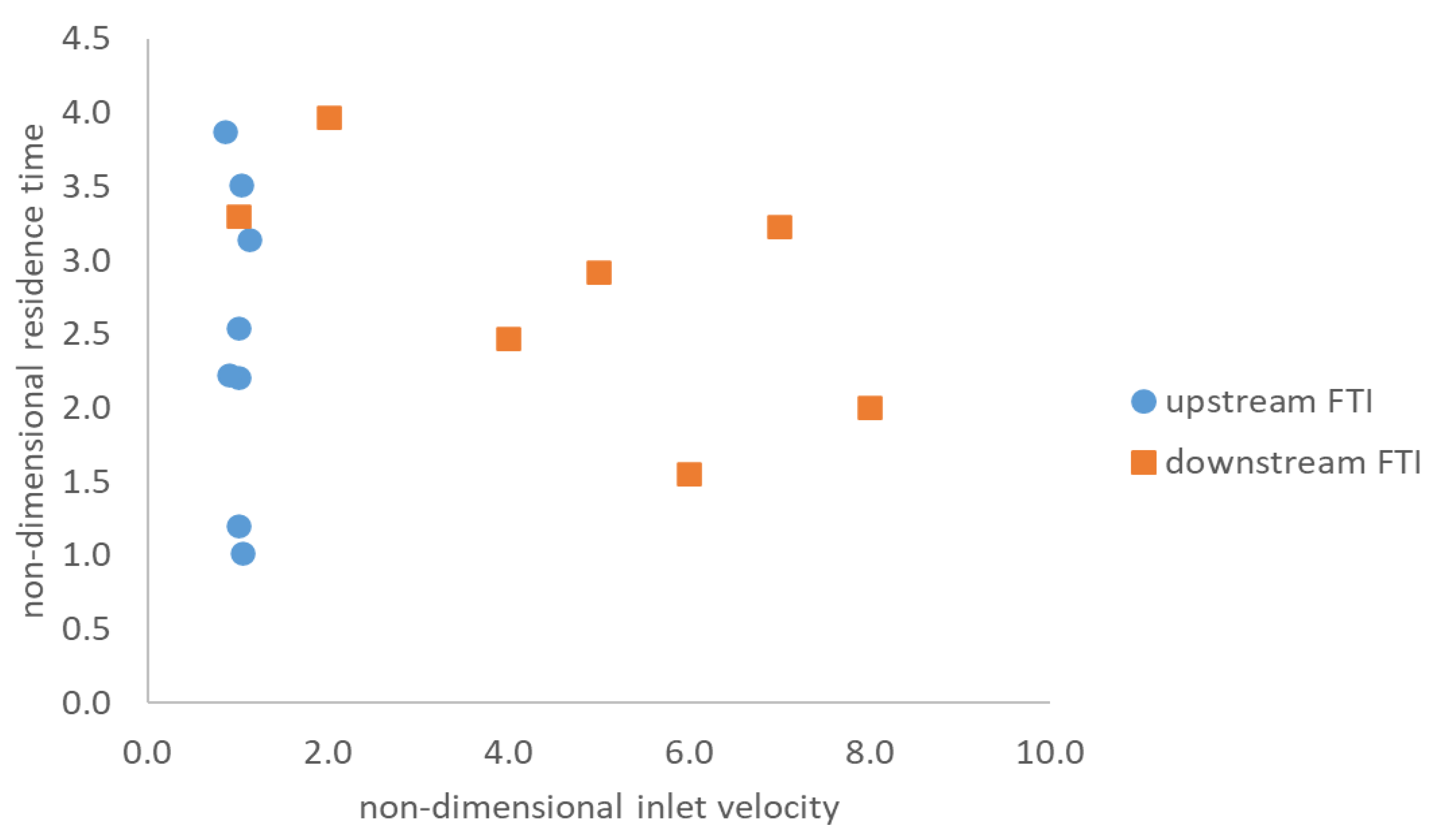
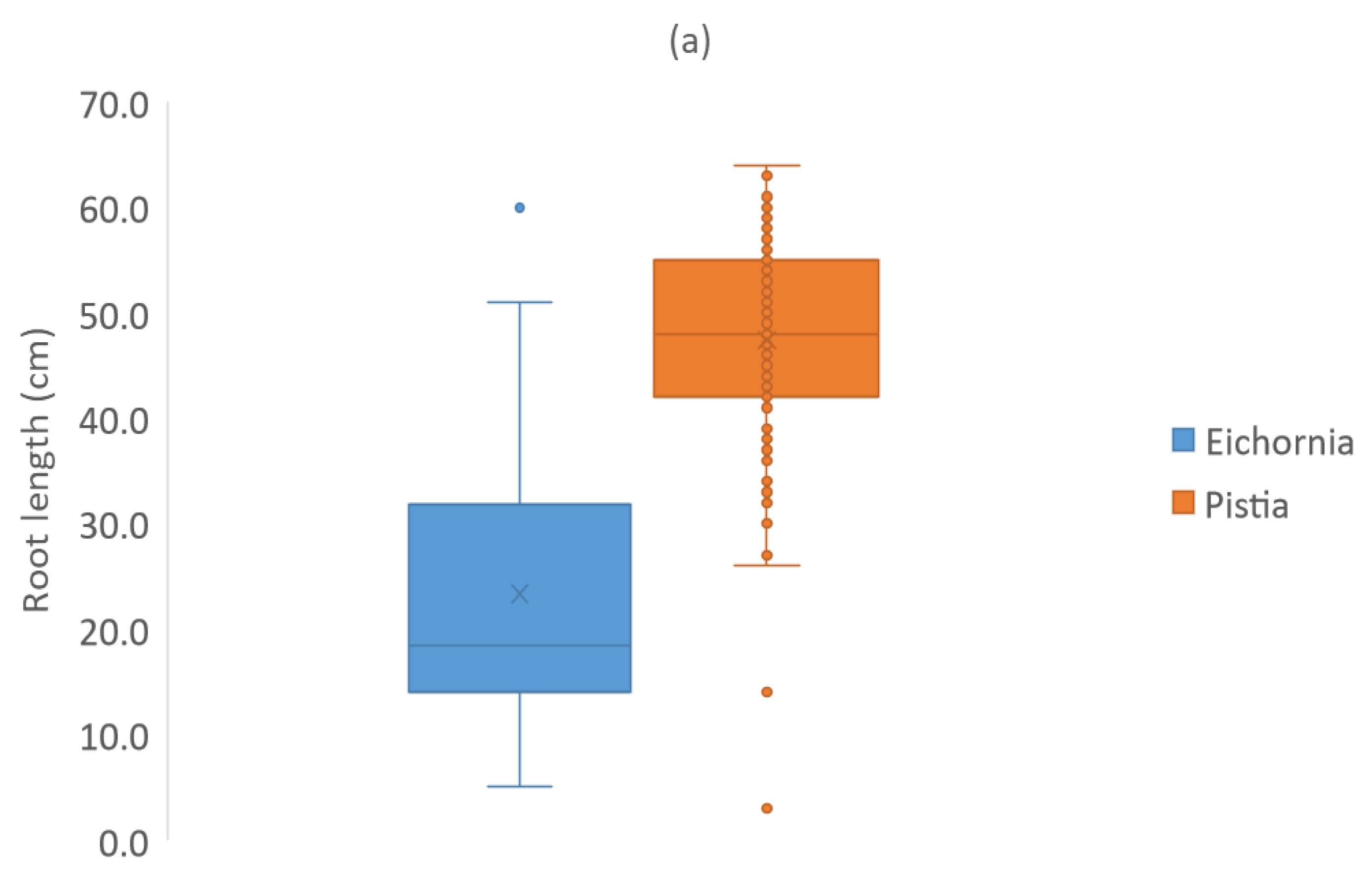
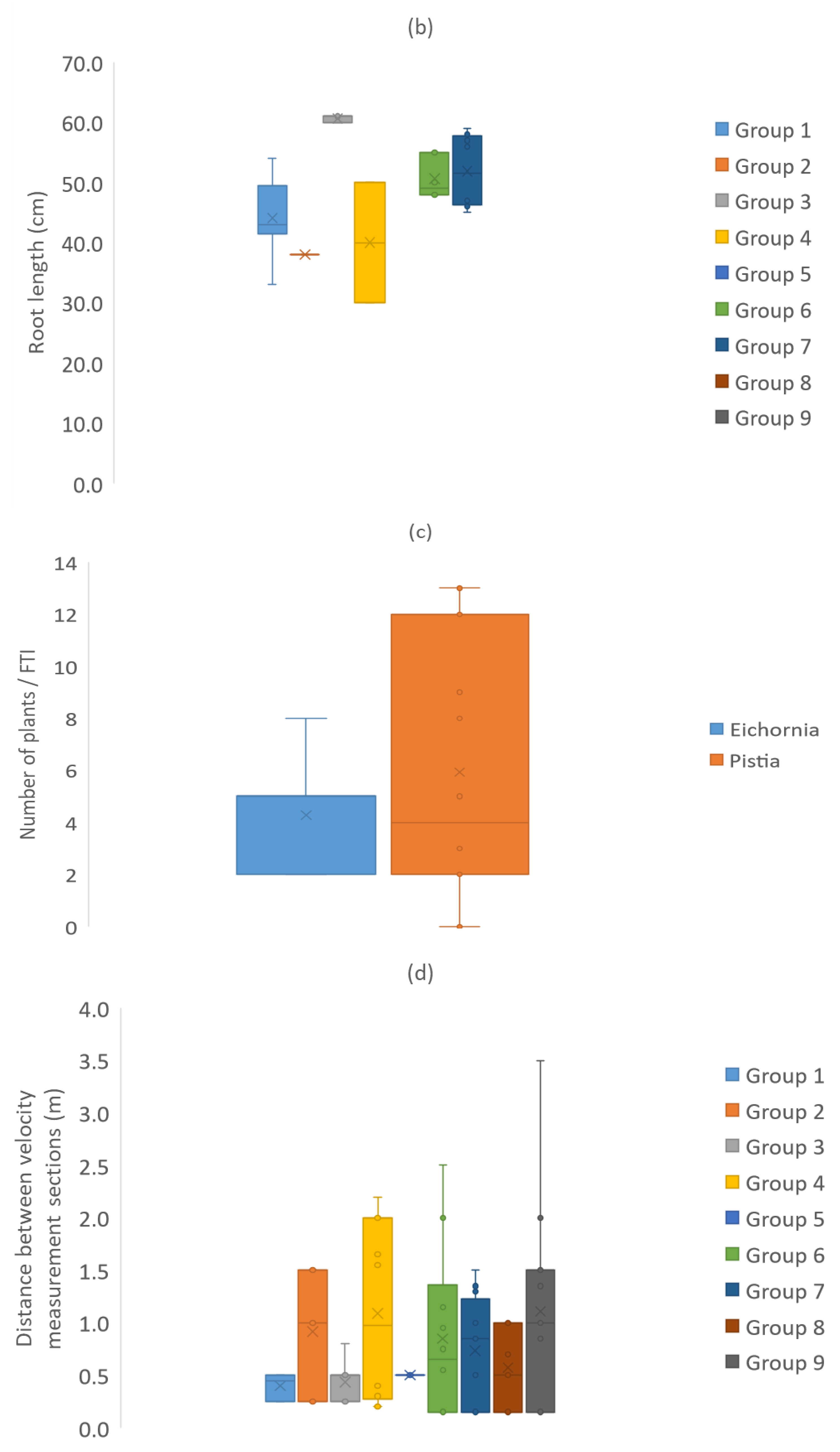
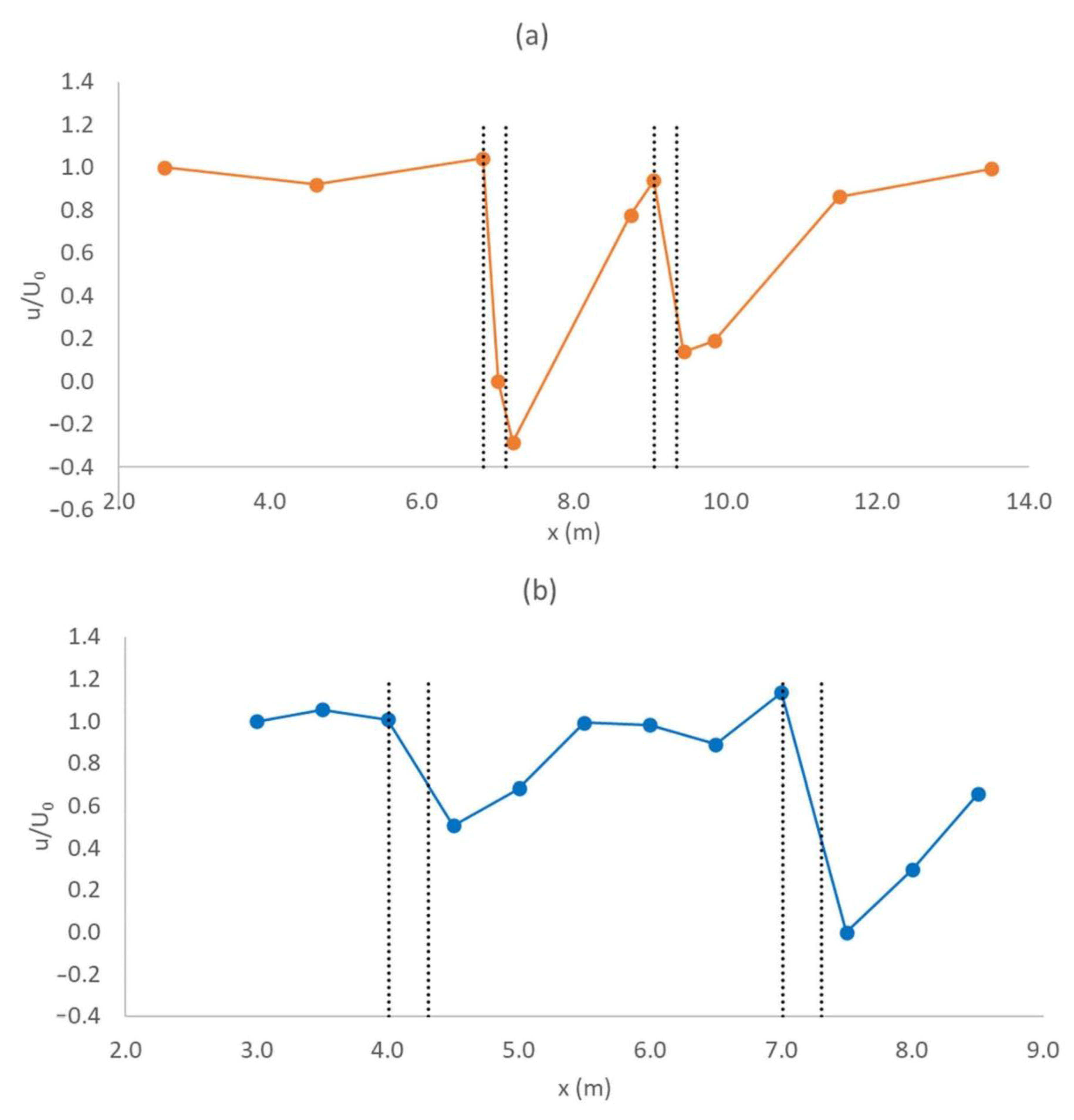
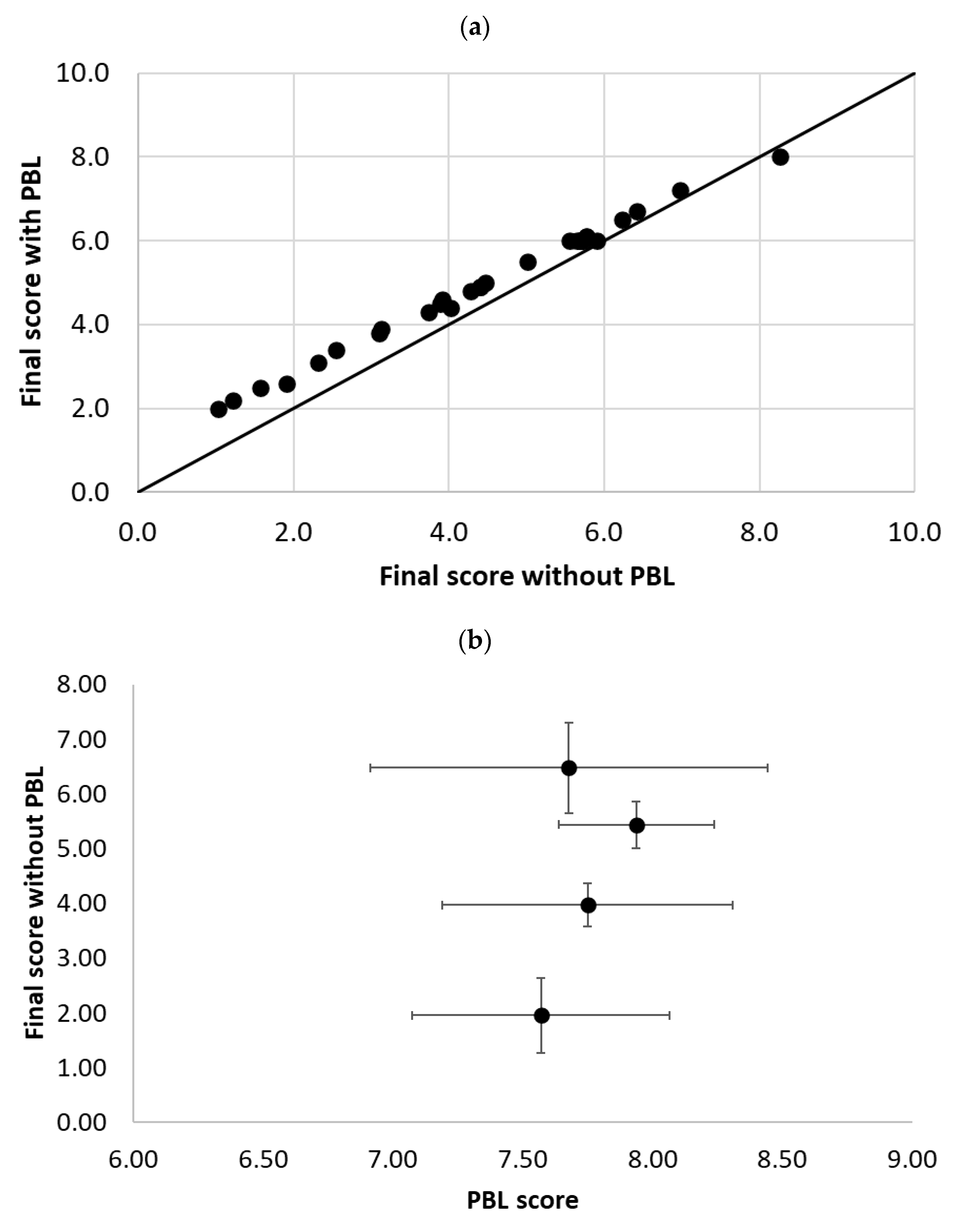
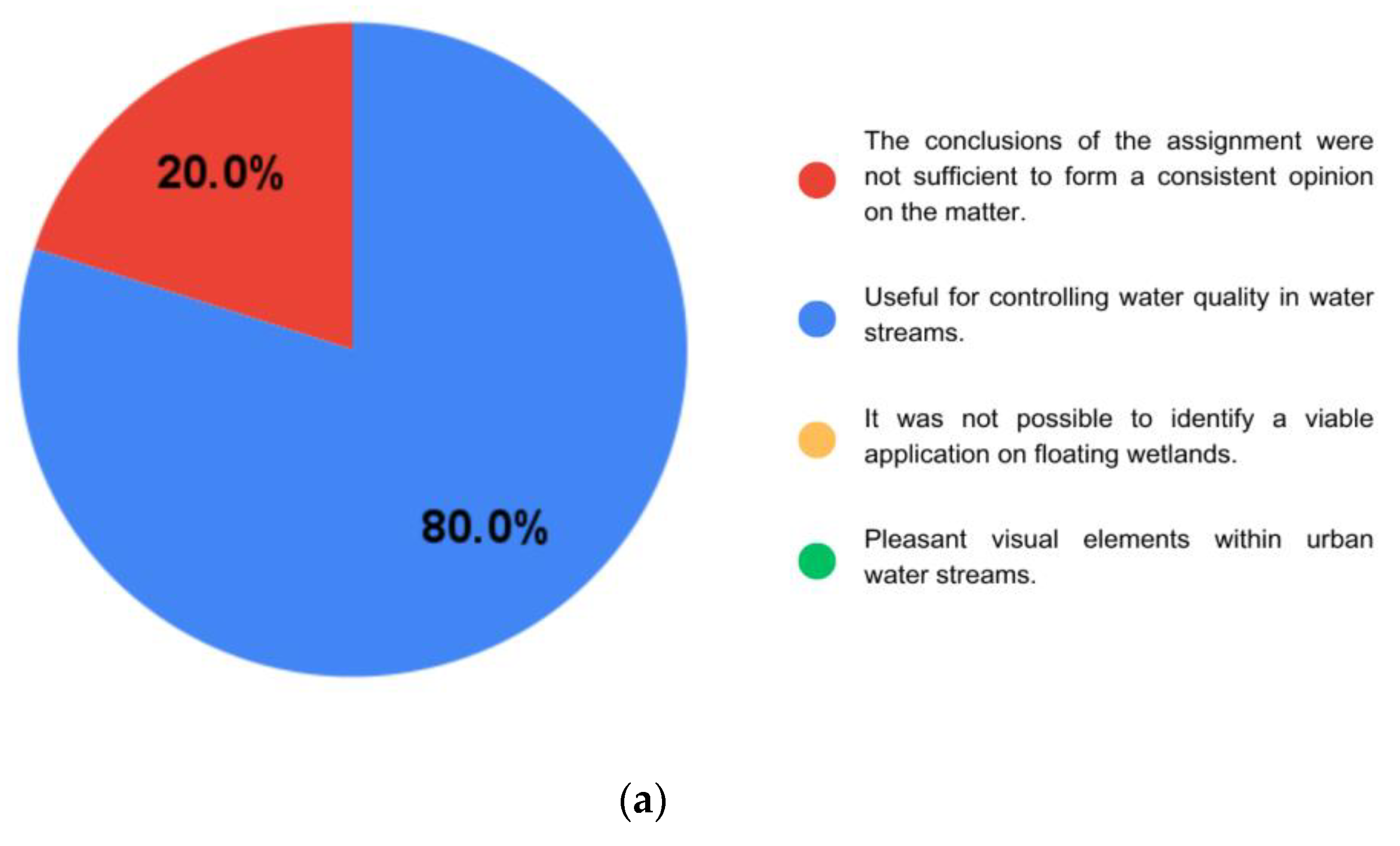
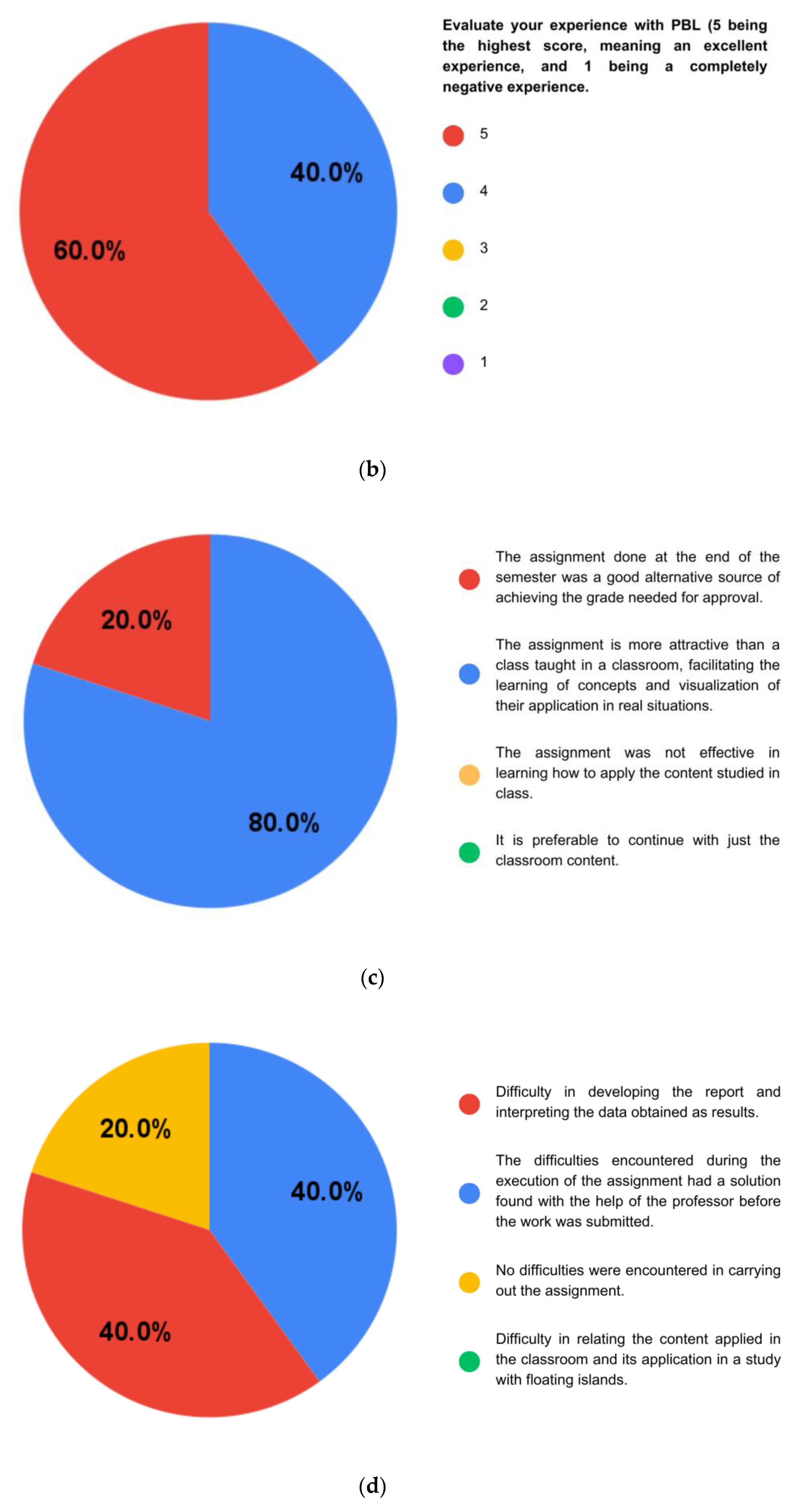
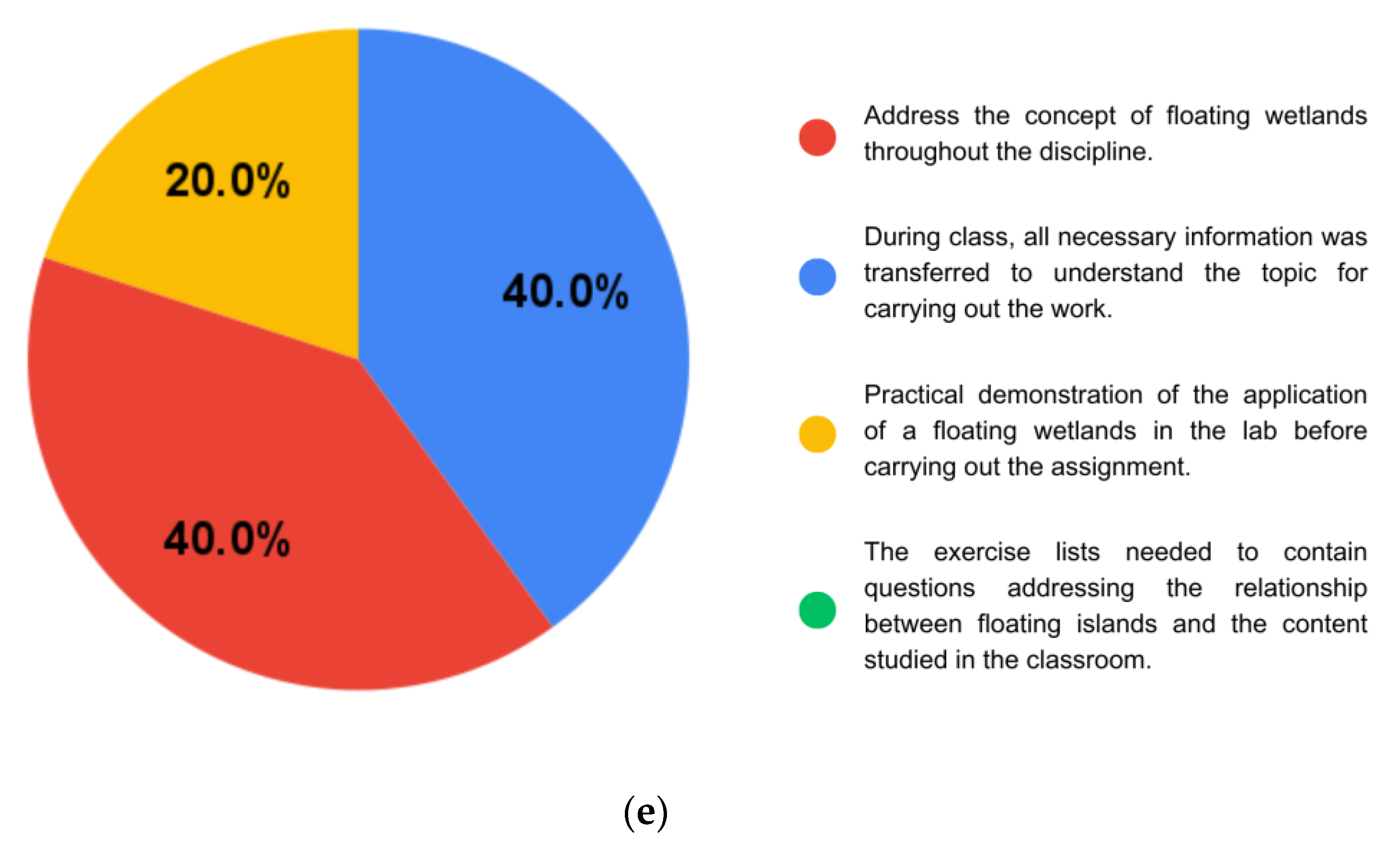
| Criterion | Excellent (9–10) | Good (7–8.9) | Satisfactory (5–6.9) | Needs Improvement (<5) |
|---|---|---|---|---|
| Report Length (2500–5000 words) | Fully meets word count | Slightly below/above | Significantly off target | Incomplete |
| Topic Structure | Clear, logical flow | Minor organizational issues | Disorganized structure | Unclear or missing |
| Measured Velocity Graphs | Accurate, well-labeled | Minor errors or labels | Incomplete or unclear | Absent or incorrect |
| Mass Removal Calculations | Precise, correct | Minor errors | Significant errors | Absent or incorrect |
| All Measurements Presented | All included, detailed | Most included | Some missing | Few or none presented |
| Experimental Uncertainty | Thoroughly propagated | Partially propagated | Minimal propagation | Not addressed |
| 1 Photo of the Island | High-quality, relevant | Acceptable quality | Poor quality | Missing |
| No Plagiarism | Fully original | Minor citation issues | Notable plagiarism | Significant plagiarism |
| ABNT-Compliant References | Fully compliant | Minor formatting errors | Major errors | Absent or incorrect |
Disclaimer/Publisher’s Note: The statements, opinions and data contained in all publications are solely those of the individual author(s) and contributor(s) and not of MDPI and/or the editor(s). MDPI and/or the editor(s) disclaim responsibility for any injury to people or property resulting from any ideas, methods, instructions or products referred to in the content. |
© 2025 by the authors. Licensee MDPI, Basel, Switzerland. This article is an open access article distributed under the terms and conditions of the Creative Commons Attribution (CC BY) license (https://creativecommons.org/licenses/by/4.0/).
Share and Cite
Pereira, R.B.; da Costa, F.R.; da Costa, L.R.; Moraes, L.E.F.; Janzen, B.; Feitosa, V.M.; Janzen, J.G. Enhancing Engineering Education in Transport Phenomena Through Project-Based Learning with a Nature-Based Solution Approach. Educ. Sci. 2025, 15, 1050. https://doi.org/10.3390/educsci15081050
Pereira RB, da Costa FR, da Costa LR, Moraes LEF, Janzen B, Feitosa VM, Janzen JG. Enhancing Engineering Education in Transport Phenomena Through Project-Based Learning with a Nature-Based Solution Approach. Education Sciences. 2025; 15(8):1050. https://doi.org/10.3390/educsci15081050
Chicago/Turabian StylePereira, Rodrigo Bahia, Felipe Rezende da Costa, Luana Ramira da Costa, Luiz Eduardo Fernandes Moraes, Bianca Janzen, Vanessa Maia Feitosa, and Johannes Gérson Janzen. 2025. "Enhancing Engineering Education in Transport Phenomena Through Project-Based Learning with a Nature-Based Solution Approach" Education Sciences 15, no. 8: 1050. https://doi.org/10.3390/educsci15081050
APA StylePereira, R. B., da Costa, F. R., da Costa, L. R., Moraes, L. E. F., Janzen, B., Feitosa, V. M., & Janzen, J. G. (2025). Enhancing Engineering Education in Transport Phenomena Through Project-Based Learning with a Nature-Based Solution Approach. Education Sciences, 15(8), 1050. https://doi.org/10.3390/educsci15081050






